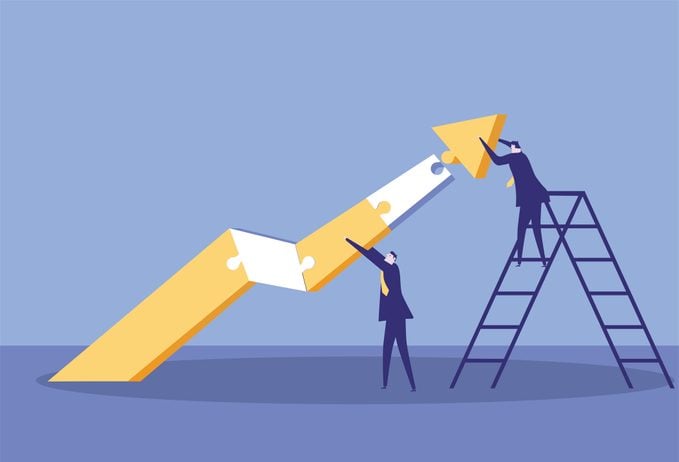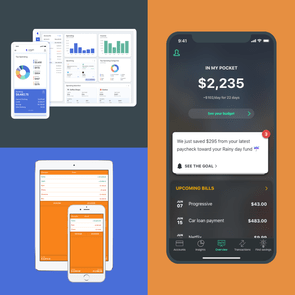I Was Finally Able to Get Out of Debt with This Mindset Shift
Updated: Jan. 10, 2023

I tried every money-saving strategy in the book. None of it worked until I traded my scarcity mindset for an abundance mindset.
A quick internet search for how to save money or how to get out of debt will tell you how to make money fast, what to stop buying if you want to save big and which side hustle ideas will rake in the most dough. What it won’t tell you, however, is that having an abundance mindset plays just as big a role as lowering your household bills or following the recommended money-saving tricks.
Trust me. I’ve been there. A few years ago, I found myself over $88,000 in debt. Two car loans, a handful of medical bills and my master’s degree had our family living paycheck to paycheck. Of course, I tried all the typical suggestions to save money: I cut cable, stopped eating out, passed on new clothes and even learned how to coupon.
It was never enough. We were in such a deep hole that saving a few hundred dollars each month felt like a drop in the bucket. It wasn’t until I adopted an abundance mindset—a view that there are infinite resources and possibilities available—that I was able to succeed.
Shifting my mindset
The road to financial security isn’t short, smooth and lined with money trees. It’s tough to even find the path out of debt, let alone make the intimidating journey toward financial freedom. My husband and I knew we were tired of living paycheck to paycheck, but we felt so defeated that we had a hard time taking the first step.
I stayed home with our three children, and it didn’t make sense for me to go to work—the cost of child care would eat up whatever I made. So my husband started revamping his resume in hopes of finding a better-paying job. Our scarcity mindset told us there simply wasn’t enough time, money, energy or available work to make a real change.
Then the universe stepped in.
As I cooked dinner one night, I listened to a podcast on which financial expert Dave Ramsey was a guest. I liked what he had to say and made a mental note to google him after the kids went to bed that night. A short while later, my husband walked in the door, and before he even put his things down, he told me that he had been listening to a podcast on his way home from work and asked if I could swing by our library the next day to pick up a book by this guy named Dave Ramsey.
Yep, we had been listening to the exact same podcast. The next day, I borrowed The Total Money Makeover from our library. (There are plenty of places to find audiobooks and other books for free online—you can download free books for Kindle—but I still rely on my local library for free print books.)
My husband and I read it together in about two days, and for the first time ever, we thought maybe there was a light at the end of this tunnel. The plan seemed so simple, and reading stories about people who had successfully completed it helped us believe that maybe there were enough opportunities, jobs and money out there to make a change in our lives.
There were so many more possibilities than we had considered. And just like that, we had gone from a scarcity mindset to an abundance mindset.
Making a plan

The decision to follow Dave Ramsey’s plan was an easy one. After all, we desperately wanted a change, and his Seven Baby Steps program seemed simple and straightforward. To get out of debt, all we had to do was create a small emergency fund and then attack our debts from smallest to largest until they were all gone.
Taking one baby step at a time, like focusing on a $300 medical bill, was far less overwhelming than looking at the whole picture of what we owed. We created a chart so we could cross off each debt as we paid it off. And for the first few months, we were crossing off small debts left and right.
With each red line we made on our chart, we truly felt like change was ours for the taking. The feelings of abundance didn’t stop there: Not only was this plan helping us get out of debt, but it was putting us on a path to a financially sound future with adequate savings, retirement contributions, college planning and wealth building.
Putting in the hard work
Executing the plan, on the other hand, wasn’t quite so simple. Friends thought we were crazy. They reminded us that we only live once, and everyone has debt. One friend even forwarded me an article about how Dave Ramsey and his plan were toxic because “YOLO.”
And I get that side of it. I love traveling and Broadway shows, and I want to be able to give my children experiences that I didn’t have growing up. And sure, I could die tomorrow. Why not do the things that make me happy today instead of focusing on meal planning, building budget grocery lists or attempting to get free stuff?
Except living paycheck to paycheck wasn’t making me happy. I felt hopeless and trapped. The feeling didn’t ebb when we crunched the numbers and learned that it could take us three years to complete this plan. Three years seemed like an eternity. But we had gone from feeling like we would never be able to get ahead to thinking about all the things we’d be able to do if we weren’t saddled with so much debt.
Approaching work with an abundance mindset
With my scarcity mindset, it didn’t make sense for me to go back to work full time. Child care was too expensive, all my licenses and certificates were in another state and I had already been out of the workforce for what I thought was too long. There was nothing I could do.
But with an abundance mindset, I realized that it didn’t have to be all or nothing. I had the opportunity to get a part-time job and throw all that income at our debt. Even a little extra cash could help us get out of debt sooner. (Like the “every little bit counts” mentality? You’ll probably love the FIRE movement, which aims for early retirement.)
I had some waitressing experience, and a popular restaurant in town offered me a job, promising I could make a few hundred dollars a night as a server. That sounded great … until I went in for my first shift and it dawned on me that I would probably end up waiting on people I knew, like other moms I’m friendly with. What would they think of me waiting tables? I knew it was a shallow thought. My old scarcity mindset was rearing its ugly head, but it was still hard to push my insecurities to the side.
As it turned out, I did wait on moms in town. Lots of them. Some were kind and chatted as they ordered their cocktails, while others looked as if they felt sorry for me. Most of them left overly generous tips, which was kind and also kind of awkward. But ultimately, it wasn’t as horrible as I had imagined it to be.
The hardest part was the schedule. My husband went to work during the day while I took care of our children and house. And as soon as he came home, we gave each other a quick rundown of our days, and I updated him on the kids before I ran out the door to work. I’d get home sometime between 11 p.m. and midnight, with just enough energy left to take a shower before crawling into bed.
It wasn’t easy, but my extra income was helping us make real progress. And the more progress we made, the stronger our abundance mindset became. It became clear we really could do this. And we were on track to finish sooner than our original three-year estimate.
Staying the course
In the end, our journey to get out of debt was 22 months of sacrifices and hectic schedules. There were times when one of us wanted to take a break from paying down our debt. After all, we’d come so far, so surely we could veer off the path just a little—you know, hit that cute boutique for a capsule wardrobe instead of shopping at online thrift stores.
Luckily, we never felt that way at the same time. We held each other accountable, throwing every extra dollar we could at our debt. And we reminded each other that our sacrifices and crazy schedules were only temporary.
Well, they were supposed to be temporary. My new mindset had me stay the course longer than I had originally planned. My part-time job as a waitress helped us pay off our debt over a year ahead of schedule. That meant it could also help us build our emergency fund faster and maybe even help plan a fun celebration for what we had accomplished.
I continued waiting tables for about six months after we had paid off our debt. Though I scaled back my hours, I missed my family. I wanted date nights with my husband, family movie nights with our children and girls nights with my friends. And once we were debt-free, we realized how comfortably we could live on just one salary. The restaurant went from being my place of employment to one of our favorite date-night spots.
Reaping the rewards
It’s been almost three years since we finished paying off our debt, and we don’t regret a single thing. The first time I fully realized just what we had accomplished, I teared up.
When schools were reopening after the pandemic, I had a first grader who thrived on structure. Being in school and then out of school for virtual learning and then shifting to a hybrid model—all with two toddlers running around at home—would have been disastrous for our family. But because we had no debt, we realized we were not at the mercy of whoever was making school-related decisions. We were able to put our daughter into private school, which was offering in-person learning five days a week.
Knowing that we had the financial freedom to make the best decision for our family was an incredible feeling. Being debt-free has also allowed us to create a sinking fund (savings for future expenses, like a vacation), which helps us avoid months when money is extra tight.
We’ve also learned that vacation feels different when you know you won’t spend the next six months paying it off. We now have room in our budget for fun things like taking an impromptu trip to see a Broadway show or springing for good seats at a concert. And we now have weekly date nights.
But the best part? Paying off our debt strengthened our marriage, which is something I hadn’t expected. Maybe it’s because my husband and I did something hard, and we did it together. Maybe it’s because everyone around us thought we were crazy or because we really held each other accountable. Or maybe things are just better because we no longer have any financial stress. Whatever the reason, those 22 crazy months were worth it.

















